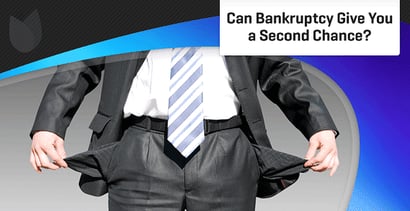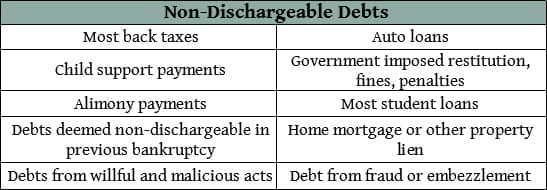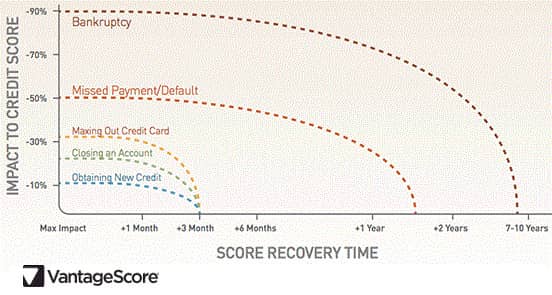

In 2016, there were over 794,000 bankruptcy filings in the US. Many people see bankruptcy as a way of escaping their debts and responsibilities to start over again. And in some ways, that’s true. But bankruptcy isn’t a get-out-of-jail-free card, and it doesn’t give you a free pass to walk away from a financial mess without consequences.
That’s why you should make sure you have a full understanding of what the bankruptcy process entails — and the ways it will impact your life for years to come — before you consider filing.
What Is Bankruptcy?
Bankruptcy can provide a safety net for those who are uncontrollably spiraling into increasing amounts of debt. It can stop wage garnishments, debt collectors, repossession, and other legal actions. In some ways, bankruptcy is like a tourniquet for your debts, and it can stop the uncontrollable bleeding — but it comes at a cost.
That said, bankruptcy won’t remove all of your financial responsibilities. The following types of debts and obligations can’t be discharged through bankruptcy:

Bankruptcy also won’t protect anyone who cosigned your debts, because your cosigner agreed to pay your loan if you don’t (or can’t) pay it as agreed.
Types of Bankruptcy
There are several types of bankruptcy that individuals and married couples can apply for, but Chapter 7 and Chapter 13 are the most common forms of bankruptcy filed by consumers. While you can typically convert from one type to another, not all consumers will qualify for both types of bankruptcy.
Chapter 7 Bankruptcy
Chapter 7 bankruptcy can wipe out many of your debts within three to six months. A court judgment frees you from the responsibility of repaying those debts. However, Chapter 7 won’t protect all of your property, and some of your assets could be sold off to repay part of your debt.
Property that can’t be repossessed and sold is categorized as “exempt.” Exempt assets include your home, car, work-related equipment, Social Security checks and other benefits, and retirement savings.
Non-exempt property includes cash, bank accounts, investments, valuable collections, a second car, and other saleable possessions. You should be prepared for all of your non-exempt assets to be sold off to repay your debt.
Chapter 13 Bankruptcy
Chapter 13 bankruptcy can take years rather than months, and you will be required to repay some portion of your debts to have the rest forgiven. On the other hand, Chapter 13 allows you to maintain ownership of your property and assets. There are certain requirements for applying for Chapter 13:
- Your debts may not exceed a certain amount (re-evaluated on a regular basis)
- You must design a three- to five-year repayment plan
Once you complete the repayment plan, your remaining debts are forgiven. However, most people don’t successfully complete their repayment plan, and they often eventually declare Chapter 7 bankruptcy.
Consequences of Bankruptcy
Whether you file for Chapter 7 or Chapter 13 bankruptcy, you will still have legal obligations to your creditors. But there are also other consequences of bankruptcy that will significantly impact many aspects of your life. Let’s look closer at the immediate and long-term consequences of bankruptcy that you should be prepared to face.
Your private life will be exposed. When you file for bankruptcy, you will need to show every aspect of your financial life to the court — and that means your private life will come under scrutiny as well.
You will lose the things you love. Under Chapter 7, certain belongings will be sold off to repay your debts. Expect to lose anything of value other than your home and primary vehicle. Family heirlooms, electronics, collectibles, musical instruments, hobby equipment — these things and more are likely to be taken.
Your relationships may suffer. Bankruptcy is incredibly stressful, and it can have a powerful impact on your family life. Stress can impact your friendships, work relationships, and even the quality of your work. Some marriages have been ruined by bankruptcy.
Your insurance rates will go up. Insurance companies look at your credit history to determine what kind of a risk you present. Just as multiple car accidents or traffic tickets make you a risky person to insure, bankruptcy makes you look like a risky customer for paying your bills — which can directly impact your rates.
Bankruptcy will loom over your head for a decade. Bankruptcy stays on your credit report for either seven (Chapter 13) or 10 (Chapter 7) years. During this time, it will be much more difficult to get approved for lines of credit, including mortgages or small business loans. Even if you are approved, be prepared to pay higher interest rates and fees than consumers with better credit are charged.

You might not find a new job. Some employers check the credit reports of their job applicants. If you’re looking for a new job after declaring bankruptcy, you could find it harder to get hired for another seven to 10 years. This may be the ideal time then to consider a reputable credit repair company.
If you choose to move forward and file for bankruptcy, you should seriously consider these short-term and long-term impacts you’re likely to deal with.
Second Chance with Bankruptcy
Even though bankruptcy comes with a cost, it does give you the opportunity for a fresh financial start, which is the intention behind the process — to give debtors a way to get back on their feet. Bankruptcy can relieve debtors of a huge weight of debt that they would never be able to pay off, and gives them a chance to start with a blank slate.
Although the bankruptcy will stay on your credit report for up to 10 years, its effects will lessen over time. You can begin to rebuild good credit by making monthly payments (such as rent, insurance, and utilities) on time. Of course, making the most of your second chance means you’ll need to change your financial habits. This will include taking positive steps such as:
- Creating and following a budget
- Paying your entire credit card balance each month
- Minimizing frivolous spending
- Making smart financial investments for the future
- Putting together an emergency fund to cover unexpected expenses
These practices can be painful at first, especially if you’ve been practicing poor financial habits for years. But the purpose of going through bankruptcy is to not erase the past, but learn from it, so that you can begin to financially flourish for years to come.
If you think bankruptcy might be your best option, talk to a bankruptcy attorney to get a legal assessment. An experienced professional can help you evaluate your best options to get your debts under control.
Advertiser Disclosure
BadCredit.org is a free online resource that offers valuable content and comparison services to users. To keep this resource 100% free for users, we receive advertising compensation from the financial products listed on this page. Along with key review factors, this compensation may impact how and where products appear on the page (including, for example, the order in which they appear). BadCredit.org does not include listings for all financial products.
Our Editorial Review Policy
Our site is committed to publishing independent, accurate content guided by strict editorial guidelines. Before articles and reviews are published on our site, they undergo a thorough review process performed by a team of independent editors and subject-matter experts to ensure the content’s accuracy, timeliness, and impartiality. Our editorial team is separate and independent of our site’s advertisers, and the opinions they express on our site are their own. To read more about our team members and their editorial backgrounds, please visit our site’s About page.



